NASA Released The Clearest Images Of Neptune’s Rings In Over 30 Years.
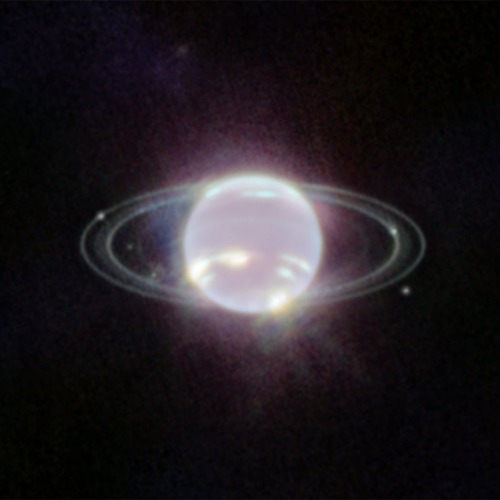
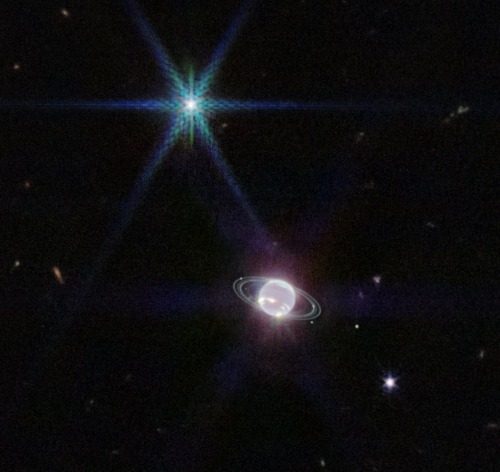
NASA released the clearest images of Neptune’s rings in over 30 years.
More Posts from Night-hides-the-world and Others


Venezuela by Jonas Piontek
A universe in motion seen from the International Space Station during a night pass over Earth.
(@ wonderofscience on Twitter)
Timelapse created from images courtesy of the Earth Science and Remote Sensing Unit, NASA Johnson Space Center(ISS061-E-110520-111341 eol.jsc.nasa.gov).
New Science from our Mission to Touch the Sun

In August 2018, our Parker Solar Probe mission launched to space, soon becoming the closest-ever spacecraft from the Sun. Now, scientists have announced their first discoveries from this exploration of our star!
The Sun may look calm to us here on Earth, but it’s an active star, unleashing powerful bursts of light, deluges of particles moving near the speed of light and billion-ton clouds of magnetized material. All of this activity can affect our technology here on Earth and in space.
Parker Solar Probe’s main science goals are to understand the physics that drive this activity — and its up-close look has given us a brand-new perspective. Here are a few highlights from what we’ve learned so far.
1. Surprising events in the solar wind
The Sun releases a continual outflow of magnetized material called the solar wind, which shapes space weather near Earth. Observed near Earth, the solar wind is a relatively uniform flow of plasma, with occasional turbulent tumbles. Closer to the solar wind’s source, Parker Solar Probe saw a much different picture: a complicated, active system.
One type of event in particular drew the eye of the science teams: flips in the direction of the magnetic field, which flows out from the Sun, embedded in the solar wind. These reversals — dubbed “switchbacks” — last anywhere from a few seconds to several minutes as they flow over Parker Solar Probe. During a switchback, the magnetic field whips back on itself until it is pointed almost directly back at the Sun.

The exact source of the switchbacks isn’t yet understood, but Parker Solar Probe’s measurements have allowed scientists to narrow down the possibilities — and observations from the mission’s 21 remaining solar flybys should help scientists better understand these events.
2. Seeing tiny particle events
The Sun can accelerate tiny electrons and ions into storms of energetic particles that rocket through the solar system at nearly the speed of light. These particles carry a lot of energy, so they can damage spacecraft electronics and even endanger astronauts, especially those in deep space, outside the protection of Earth’s magnetic field — and the short warning time for such particles makes them difficult to avoid.

Energetic particles from the Sun impact a detector on ESA & NASA’s SOHO satellite.
Parker Solar Probe’s energetic particle instruments have measured several never-before-seen events so small that all trace of them is lost before they reach Earth. These instruments have also measured a rare type of particle burst with a particularly high number of heavier elements — suggesting that both types of events may be more common than scientists previously thought.
3. Rotation of the solar wind
Near Earth, we see the solar wind flowing almost straight out from the Sun in all directions. But the Sun rotates as it releases the solar wind, and before it breaks free, the wind spins along in sync with the Sun’s surface. For the first time, Parker was able to observe the solar wind while it was still rotating – starting more than 20 million miles from the Sun.

The strength of the circulation was stronger than many scientists had predicted, but it also transitioned more quickly than predicted to an outward flow, which helps mask the effects of that fast rotation from the vantage point where we usually see them from, near Earth, about 93 million miles away. Understanding this transition point in the solar wind is key to helping us understand how the Sun sheds energy, with implications for the lifecycles of stars and the formation of protoplanetary disks.
4. Hints of a dust-free zone
Parker also saw the first direct evidence of dust starting to thin out near the Sun – an effect that has been theorized for nearly a century, but has been impossible to measure until now. Space is awash in dust, the cosmic crumbs of collisions that formed planets, asteroids, comets and other celestial bodies billions of years ago. Scientists have long suspected that, close to the Sun, this dust would be heated to high temperatures by powerful sunlight, turning it into a gas and creating a dust-free region around the Sun.

For the first time, Parker’s imagers saw the cosmic dust begin to thin out a little over 7 million miles from the Sun. This decrease in dust continues steadily to the current limits of Parker Solar Probe’s instruments, measurements at a little over 4 million miles from the Sun. At that rate of thinning, scientists expect to see a truly dust-free zone starting a little more than 2-3 million miles from the Sun — meaning the spacecraft could observe the dust-free zone as early as 2020, when its sixth flyby of the Sun will carry it closer to our star than ever before.
These are just a few of Parker Solar Probe’s first discoveries, and there’s plenty more science to come throughout the mission! For the latest on our Sun, follow @NASASun on Twitter and NASA Sun Science on Facebook.
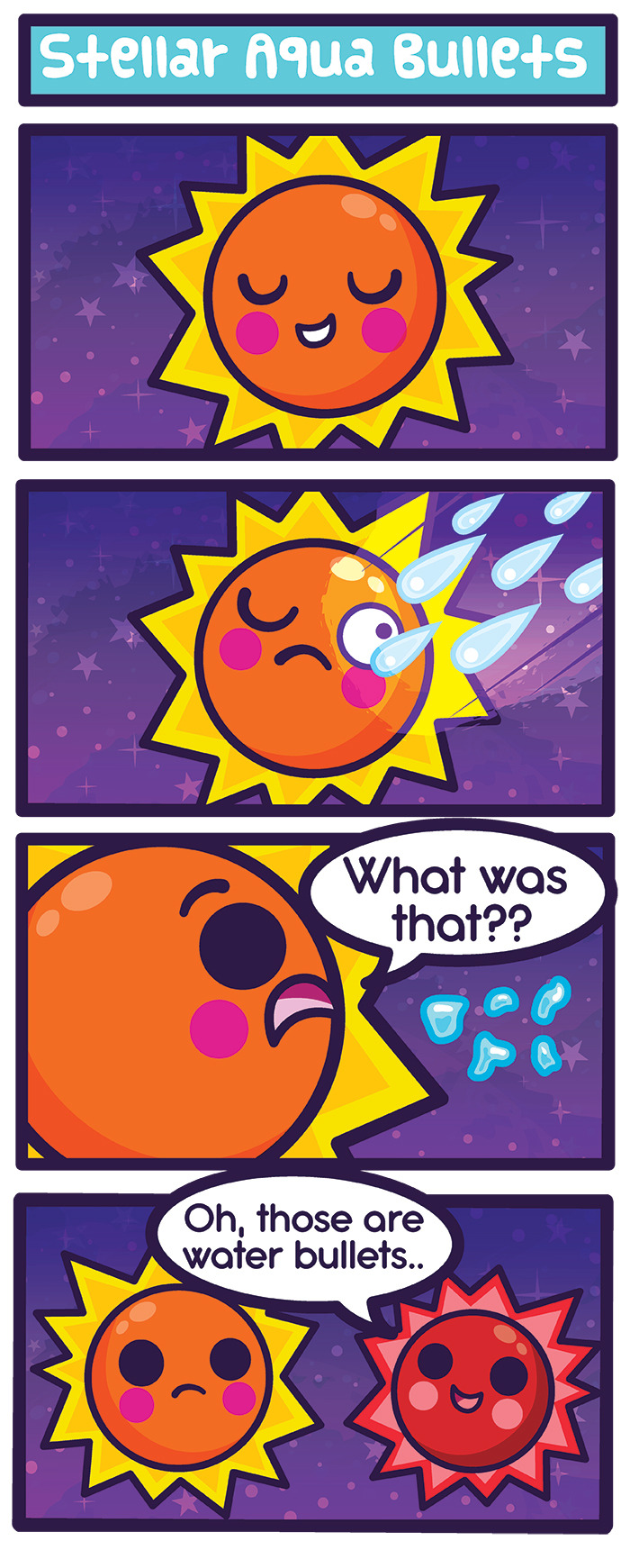
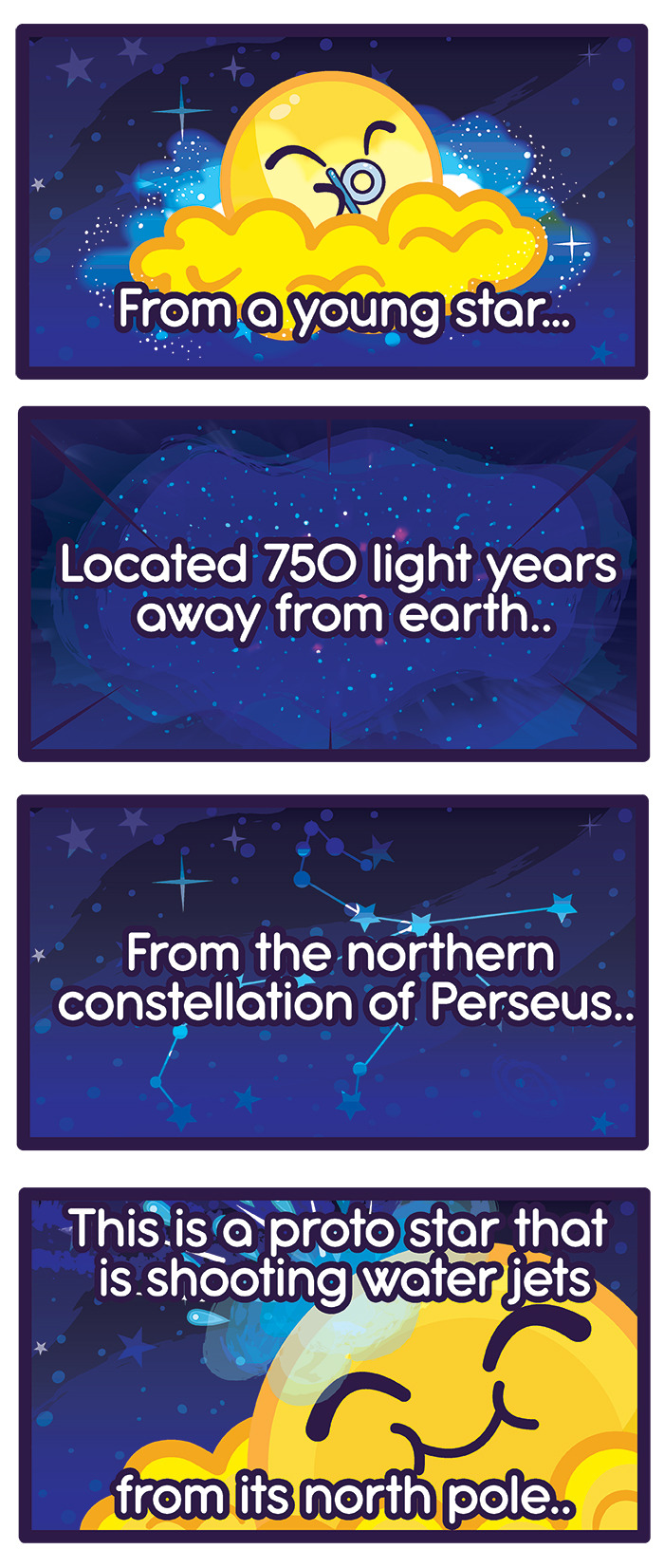

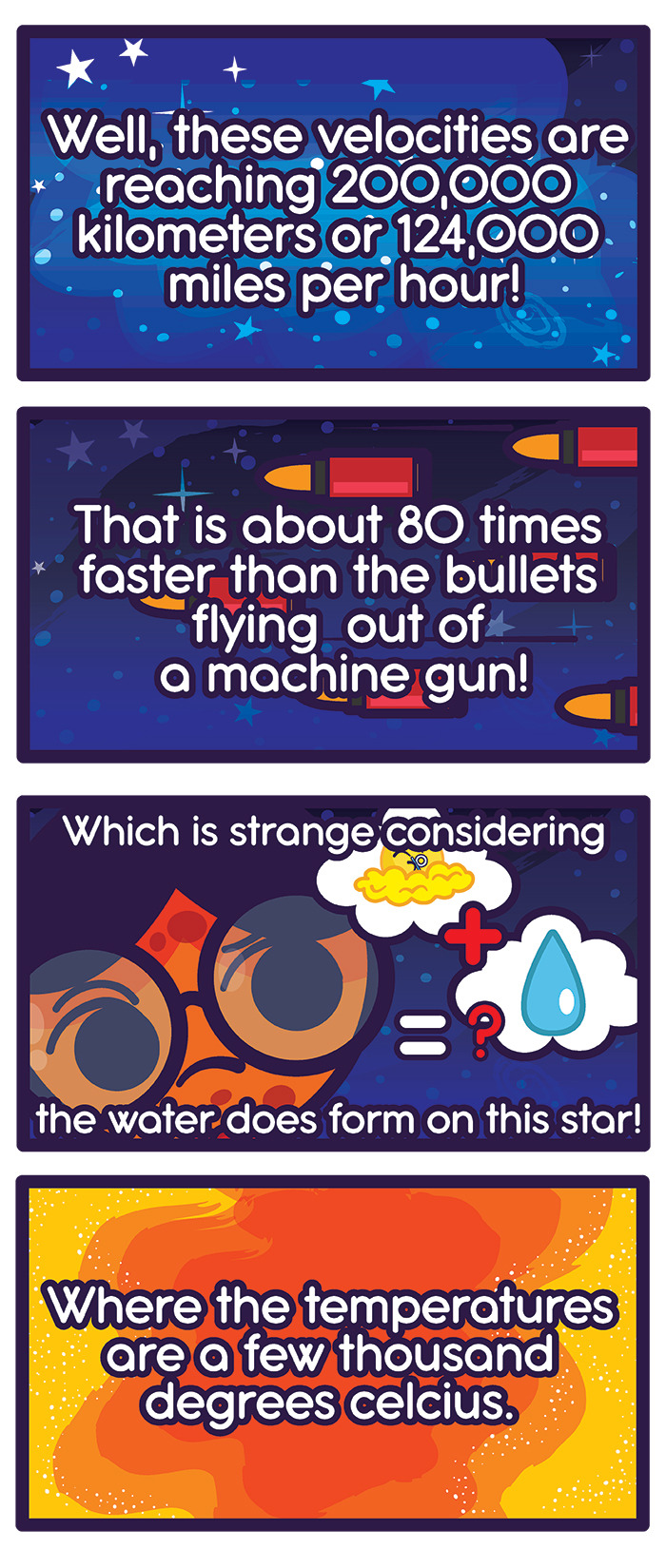
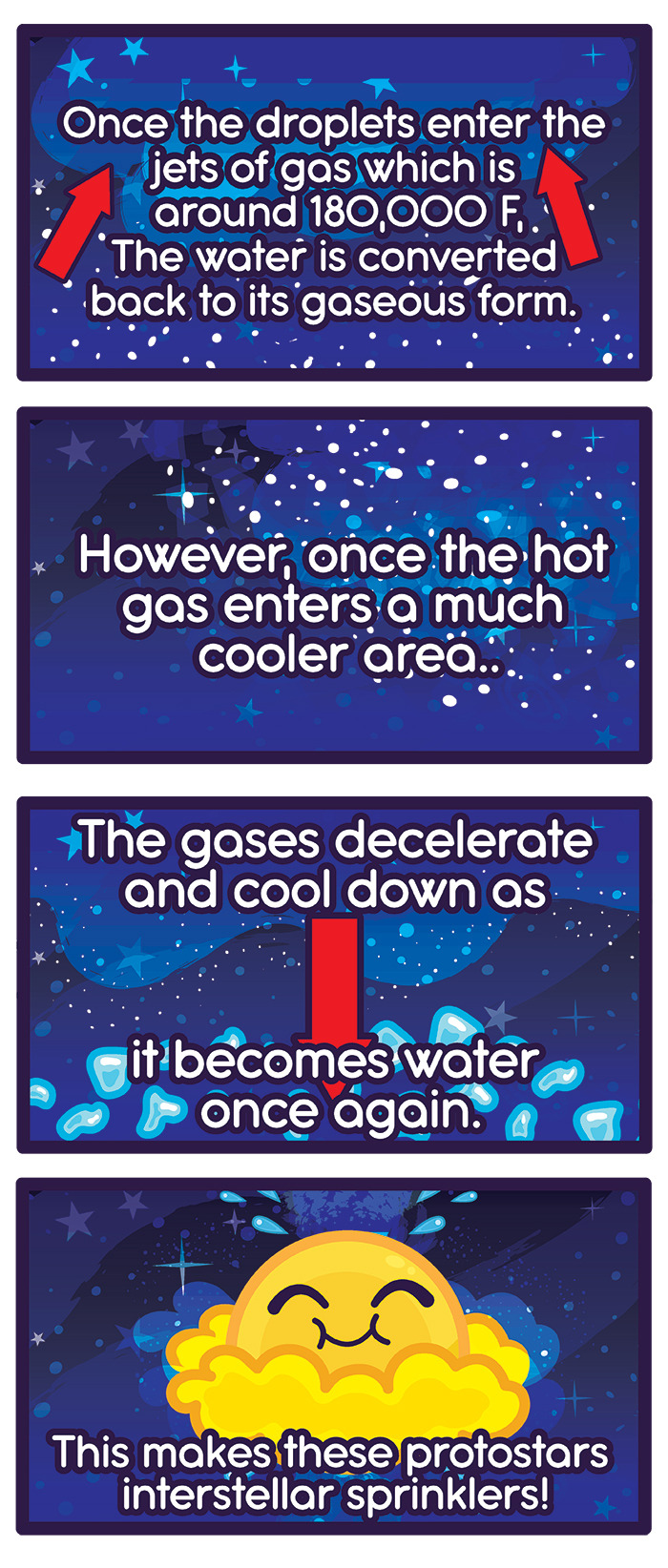

Better late than never!
Here’s a comic about a star that erupts water bullets! OoO!
https://news.nationalgeographic.com/news/2011/06/110613-space-science-star-water-bullets-kristensen/
https://www.huffpost.com/entry/star-shooting-water-jets-herschel_n_879211
https://www.popsci.com/technology/article/2011-06/herschel-spots-young-star-spewing-water-jets-interstellar-space?cmpid=tw
https://www.digitaltrends.com/web/young-stars-shoot-epic-quantities-of-water-into-space-study-shows/

This is a small portion of NGC 2023
Credit: Judy Schmidt
Hubble has discovered a dwarf star that devours its own solar system. It's like a cosmic cannibal

Astronomers used archival data from the Hubble Space Telescope and other observatories to analyze the spectral properties of the white dwarf star G238-44.
Detected elements show that the dead star swallows debris from both the inside and the outside of its system. It's a case of "cosmic cannibalism," say the study's authors, published on the Hubble Telescope website.
G238-44 was a Sun-like star that lost its outer layers and no longer burned fuel through nuclear fusion. The discovery that stellar debris simultaneously captures matter from its asteroid belt and Kuiper belt-like regions at the edge of the solar system, including ice bodies, is significant because it suggests that a "water tank" may be a common feature in outer areas. of planetary systems.
‼️When a star like the Sun expands and becomes a red giant, at the end of its life, it loses mass by releasing its outer layers.
➡️A consequence of this may be the gravitational scattering of small objects, such as asteroids, comets and satellites, to the large planets in the system. Hit in this way, surviving objects can be thrown into very eccentric orbits.‼️
☑️ "After the phase of the red giant, the remaining white dwarf star is compact - no bigger than Earth. The planets get very close to the star and experience strong forces of attraction that break them to pieces, creating a disk of gas and dust that eventually falls on the surface of the white dwarf star, "said Johnson.
![A Multi-Camera 360° Panoramic Timelapse Of The Stars By Vincent Brady [VIDEO]](https://64.media.tumblr.com/4e12ed79b6fa93fbd2f17ccd004921d6/tumblr_n7h573O5RR1rte5gyo1_500.gif)
A Multi-Camera 360° Panoramic Timelapse of the Stars by Vincent Brady [VIDEO]
-
 ninethrees liked this · 3 weeks ago
ninethrees liked this · 3 weeks ago -
 enasnivolz reblogged this · 3 weeks ago
enasnivolz reblogged this · 3 weeks ago -
 st4reat3r reblogged this · 3 weeks ago
st4reat3r reblogged this · 3 weeks ago -
 goregeousity liked this · 3 weeks ago
goregeousity liked this · 3 weeks ago -
 a-flickering-soul reblogged this · 3 weeks ago
a-flickering-soul reblogged this · 3 weeks ago -
 honeybed reblogged this · 3 weeks ago
honeybed reblogged this · 3 weeks ago -
 eddiepasketi liked this · 3 weeks ago
eddiepasketi liked this · 3 weeks ago -
 complextheories reblogged this · 3 weeks ago
complextheories reblogged this · 3 weeks ago -
 liminal-sun reblogged this · 3 weeks ago
liminal-sun reblogged this · 3 weeks ago -
 tumblidis liked this · 3 weeks ago
tumblidis liked this · 3 weeks ago -
 timetidesofficial liked this · 3 weeks ago
timetidesofficial liked this · 3 weeks ago -
 bielxperience liked this · 3 weeks ago
bielxperience liked this · 3 weeks ago -
 wrothstudio liked this · 3 weeks ago
wrothstudio liked this · 3 weeks ago -
 ilmi0labirint0 reblogged this · 3 weeks ago
ilmi0labirint0 reblogged this · 3 weeks ago -
 callmehabie reblogged this · 3 weeks ago
callmehabie reblogged this · 3 weeks ago -
 burymeinthesnow liked this · 3 weeks ago
burymeinthesnow liked this · 3 weeks ago -
 yevonchao liked this · 3 weeks ago
yevonchao liked this · 3 weeks ago -
 lovebloomsfrom liked this · 3 weeks ago
lovebloomsfrom liked this · 3 weeks ago -
 astercrash liked this · 3 weeks ago
astercrash liked this · 3 weeks ago -
 gryphonwings reblogged this · 3 weeks ago
gryphonwings reblogged this · 3 weeks ago -
 gryphonwings liked this · 3 weeks ago
gryphonwings liked this · 3 weeks ago -
 aloocha liked this · 3 weeks ago
aloocha liked this · 3 weeks ago -
 riverlarking liked this · 3 weeks ago
riverlarking liked this · 3 weeks ago -
 schech reblogged this · 3 weeks ago
schech reblogged this · 3 weeks ago -
 artcgirl reblogged this · 3 weeks ago
artcgirl reblogged this · 3 weeks ago -
 mysterious-shelf liked this · 3 weeks ago
mysterious-shelf liked this · 3 weeks ago -
 distantreverbs reblogged this · 3 weeks ago
distantreverbs reblogged this · 3 weeks ago -
 enasnivolz liked this · 4 weeks ago
enasnivolz liked this · 4 weeks ago -
 dark-sweet-muffin liked this · 4 weeks ago
dark-sweet-muffin liked this · 4 weeks ago -
 ilmi0labirint0 liked this · 4 weeks ago
ilmi0labirint0 liked this · 4 weeks ago -
 fractal-heartbeats reblogged this · 4 weeks ago
fractal-heartbeats reblogged this · 4 weeks ago -
 gladrial reblogged this · 4 weeks ago
gladrial reblogged this · 4 weeks ago -
 ruvikdrocell liked this · 4 weeks ago
ruvikdrocell liked this · 4 weeks ago -
 starbrite-owl reblogged this · 4 weeks ago
starbrite-owl reblogged this · 4 weeks ago -
 citk reblogged this · 4 weeks ago
citk reblogged this · 4 weeks ago -
 citk liked this · 4 weeks ago
citk liked this · 4 weeks ago -
 yuekts liked this · 4 weeks ago
yuekts liked this · 4 weeks ago -
 hellgrub liked this · 4 weeks ago
hellgrub liked this · 4 weeks ago -
 greenteakewpie liked this · 4 weeks ago
greenteakewpie liked this · 4 weeks ago -
 macabrevampire liked this · 4 weeks ago
macabrevampire liked this · 4 weeks ago -
 sklira liked this · 4 weeks ago
sklira liked this · 4 weeks ago -
 berru-imou liked this · 4 weeks ago
berru-imou liked this · 4 weeks ago -
 4lonekitty liked this · 4 weeks ago
4lonekitty liked this · 4 weeks ago -
 southslavicdoll liked this · 4 weeks ago
southslavicdoll liked this · 4 weeks ago -
 dawnarose reblogged this · 4 weeks ago
dawnarose reblogged this · 4 weeks ago -
 dawnarose liked this · 4 weeks ago
dawnarose liked this · 4 weeks ago -
 softselin reblogged this · 4 weeks ago
softselin reblogged this · 4 weeks ago -
 missingwife reblogged this · 4 weeks ago
missingwife reblogged this · 4 weeks ago -
 unmess reblogged this · 4 weeks ago
unmess reblogged this · 4 weeks ago
Astronomy and the other wonders you witness when you look to the skies.
115 posts










